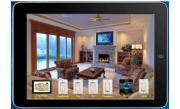|
|
|
|

|
Can You Design Your Own Touchscreen Interface
Published Mar 12, 2012
|
We love showing off home automation systems with elaborate custom-programmed touchscreens. Especially cool are the GUIs that show display the room you’re controlling and let you watch the lights turn on, the fans whirl and motorized shades drop?
JDS Technologies, one of the granddaddies of home automation, has the poor man’s version of such a system called Home Runner RBI (Remote Browser Interface) and it’s pretty slick for the price.
JDS and its owner Jeff Stein have been around the home automation industry for more than two decades. Back then, there were just a handful of systems available, and JDS was one of them. The company keeps going and going and going ….
Through the years, the company has maintained a loyal following among do-it-yourselfers and a surprising number of pros who rely on the company’s rock-solid products (yes, even with X10) and sophisticated programming tools and rules engines.
Industry long-timers might remember JDS’s flagship Stargate controller, which put many integrators into business.
The original HomeRunner, introduced a few years ago, was a Windows-based software interface for Stargate. The new HomeRunner RBI is a completely new piece of hardware and “advanced software” that enables users to create their own GUI to serve up on virtually any Web-enabled device.
It’s fun and just $499
I had a demo of the original HomeRunner a few years ago and what can I say? It’s fun. Simply take pictures of a particular room with the lights on and off (and the shades up and down, etc.) in every combination. Then assign these images to the appropriate device states.
Voila, you can virtually see the state of any given room. The interface is a true reflection of the status of a room, Stein says, because the interface does not respond unless it receives a message from the system that an action was indeed implemented properly.
It’s simple to assign “hot spots” to any part of the screen so users can, for example, touch the fan to turn it on. The software supports animated gifs so you can drop an image of a swirling fan to your room, as JDS shows in its online demo of the software (check out the living room).
Unfortunately, HomeRunner RBI only supports X10 and Insteon for home automation, as well as Global Cache products for IR, relay, IP and other communications.
“Ultimately we hope to support Z-Wave and UPB [Universal Powerline Bus], but we have received so many requests for Insteon in recent years, we opted to start with that,” Stein says.
Insteon is an RF- and powerline-enabled protocol built into a full range of home control devices including lights, thermostats, motorized shade controls, security sensors, keypads, I/O modules and more.
It ain’t for rock stars, but for $499 plus accoutrements, consumers and pros alike can create a pretty nifty smart home in no time.
Posted by
VMD - [Virtual Marketing Department]
|
|
|

